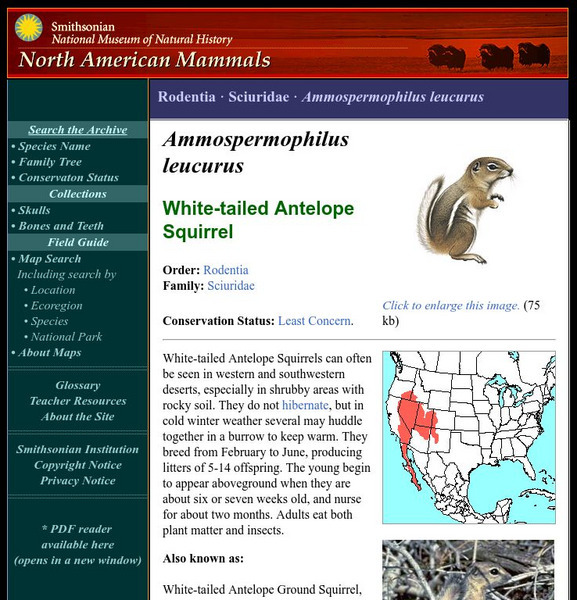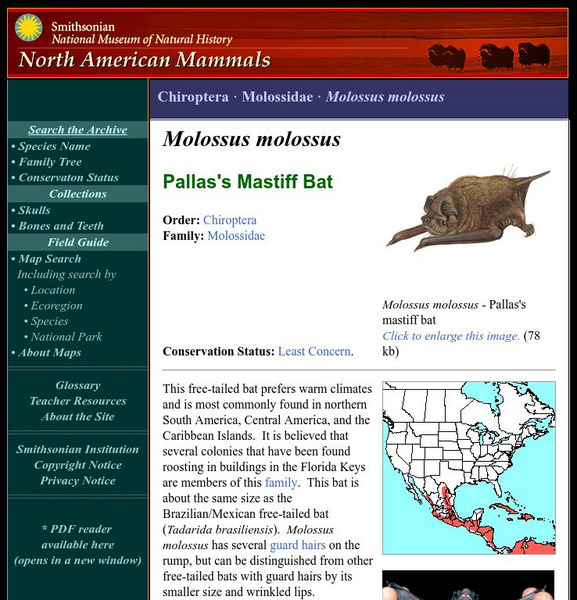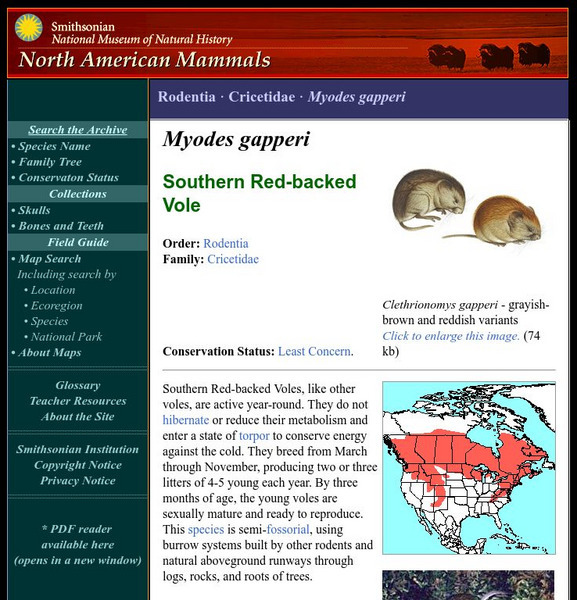Smithsonian Institution
National Museum of Natural History: American Mammals: Palmer's Chipmunk
Palmer's chipmunks live in a "sky island" mountains in southwestern Nevada surrounded by deserts the chipmunks cannot cross. They are common there, foraging where rocks or fallen logs provide cover. Learn more about the Tamias palmeri,...
Smithsonian Institution
National Museum of Natural History: American Mammals: Red Tailed Chipmunk
Red-tailed chipmunks sandbathe to clean their fur, rolling and rubbing, sometimes half-buried in sand. They are rarely seen outside their burrows on cold winter days, but in the spring they are out and about, eating seedlings, leaves,...
Smithsonian Institution
National Museum of Natural History: American Mammals: Panamint Chipmunk
Panamint chipmunks are named for the mountains in the Southwest where they were first collected by scientists, in 1890. As with many chipmunks, males and females look alike and are the same size. Learn more about the Tamias panamintinus,...
Smithsonian Institution
National Museum of Natural History: American Mammals: Siskiyou Chipmunk
Siskiyou chipmunks have their own, distinct vocalization: a long, intense, one-syllable call that starts low, rises, and then falls again. It starts at a frequency of about 300 kHz, rises to more than 1,600 kHz, then falls to about 400...
Smithsonian Institution
National Museum of Natural History: American Mammals: Sonoma Chipmunk
Young male Sonoma chipmunks disperse from the nest after weaning, but females remain near where they were born. From December through June, males travel extensively, seeking mates and competing with other males. Learn more about the...
Smithsonian Institution
National Museum of Natural History: American Mammals: San Diego Pocket Mouse
The San Diego Pocket Mouse occurs in desert and coastal habitats in southern California, Mexico, and northern Baja California, from sea level to at least 1,400 m. Yellowish or orange hair on its sides contrasts with a dark brown back,...
Smithsonian Institution
National Museum of Natural History: American Mammals: Townsend's Chipmunk
Clear-cut logging, which destroys habitat for some animals, offers good living conditions for Townsend's chipmunks. They find denning sites, cover, and food among the fallen, decaying logs and sprouting evergreens. Learn more about the...
Smithsonian Institution
National Museum of Natural History: American Mammals: Uinta Chipmunk
Uinta chipmunks are common in coniferous forests, especially at elevations higher than 1,800 m. They readily climb trees and shrubs to forage for seeds and often sleep in trees. Learn more about the Tamias umbrinus, more commonly known...
Smithsonian Institution
National Museum of Natural History: American Mammals: White Tailed Antelope Squirrel
White-tailed Antelope Squirrels can often be seen in western and southwestern deserts, especially in shrubby areas with rocky soil. They do not hibernate, but in cold winter weather, several may huddle together in a burrow to keep warm....
Smithsonian Institution
National Museum of Natural History: American Mammals: Red Squirrel
Red Squirrels are very vocal. They bark at intruders, including humans, and can bark continuously for more than an hour if they are annoyed. Learn more about the Tamiasciurus hudsonicus, more commonly known as a Red Squirrel, in this...
Smithsonian Institution
National Museum of Natural History: American Mammals: Wyoming Pocket Gopher
Wyoming Pocket Gophers are known only from a small area in south-central Wyoming. These rather small Pocket Gophers seem to prefer loose, gravelly, upland soils, often where greasewood is growing. Learn more about the Thomomys clusius,...
Smithsonian Institution
National Museum of Natural History: American Mammals: West Indian Manatee
West Indian manatees are big, slow-moving, gentle vegetarians. They live in warm, shallow water in coastal rivers, estuaries, and lagoons. Learn more about the Trichechus manatus, more commonly known as a West Indian Manatee, in this...
Smithsonian Institution
National Museum of Natural History: American Mammals: Polar Bear
Polar Bears prey mostly on Ringed Seals. In the spring, the pups are easy prey. Learn more about the Ursus maritimus, more commonly known as a Polar Bear, in this easy-to-read species overview by the Smithsonian's National Museum of...
Smithsonian Institution
National Museum of Natural History: American Mammals: Swift Fox
Swift foxes are primarily nocturnal, but can sometimes be seen sunning themselves near the entrance to a den. They live on prairie grasslands just east of the Rocky Mountains. Learn more about the Vulpes velox, more commonly known as a...
Smithsonian Institution
National Museum of Natural History: American Mammals: Red Fox
Red foxes are the most widely distributed wild carnivores in the world, occurring in North America, Asia, Europe, and North Africa. They are also widespread in Australia, where they were introduced in about 1850 so that fox-hunters would...
Smithsonian Institution
National Museum of Natural History: American Mammals: Meadow Jumping Mouse
Meadow Jumping Mice have very long tails and very large feet. They are most common in grassy or weedy fields, where they use runways made by other rodents. Learn more about the Zapus hudsonius, more commonly known as a Meadow Jumping...
Smithsonian Institution
National Museum of Natural History: American Mammals: Western Jumping Mouse
Western Jumping Mice are common in meadows, streamsides, and marshes in northwestern mountains. They also occur in subalpine meadows, and are found at low densities in dry, low-elevation, grassy habitats. Learn more about the Zapus...
Smithsonian Institution
National Museum of Natural History: American Mammals: Pacific Jumping Mouse
Pacific Jumping Mice are remarkably quick and unpredictable. They push off with both hind feet and land on both forefeet, apparently using the tail for balance--a Mouse who had lost its tail somersaulted trying to land. Learn more about...
Smithsonian Institution
National Museum of Natural History: American Mammals: Pallas's Mastiff Bat
This free-tailed bat prefers warm climates and is most commonly found in northern South America, Central America, and the Caribbean Islands. It is believed that several colonies that have been found roosting in buildings in the Florida...
Smithsonian Institution
National Museum of Natural History: American Mammals: North Pacific Right Whale
The right whales have been driven nearly to extinction as the species preferred by commercial whalers and have been hunted in spite of international bans. There are perhaps several hundred in the western Pacific, and perhaps only a...
Smithsonian Institution
National Museum of Natural History: American Mammals: Melon Headed Whale
This dark gray species is actually in the black dolphin family. It is smaller than almost all the other North American members of this family and is approximately the size of a bottlenose dolphin. Learn more about the Peponocephala...
Smithsonian Institution
National Museum of Natural History: American Mammals: Northern Red Backed Vole
The Northern Red-backed Vole lives in dry tundra and northern boreal forests (taiga). Two distinct coat coloration patterns exist within the species, one darkly colored, and a paler version. Learn more about the Clethrionomys rutilus,...
Smithsonian Institution
National Museum of Natural History: American Mammals: Western Red Backed Vole
The Western Red-backed Vole lives in conifer forests from the Columbia River south through western Oregon to northern California. Its population densities are greatest in dense, dark forests where there is little or no understory. Learn...
Smithsonian Institution
National Museum of Natural History: American Mammals: Southern Red Backed Vole
Southern Red-backed Voles, like other voles, are active year-round. They do not hibernate or reduce their metabolism and enter a state of torpor to conserve energy against the cold. Learn more about the Clethrionomys gapperi, more...























